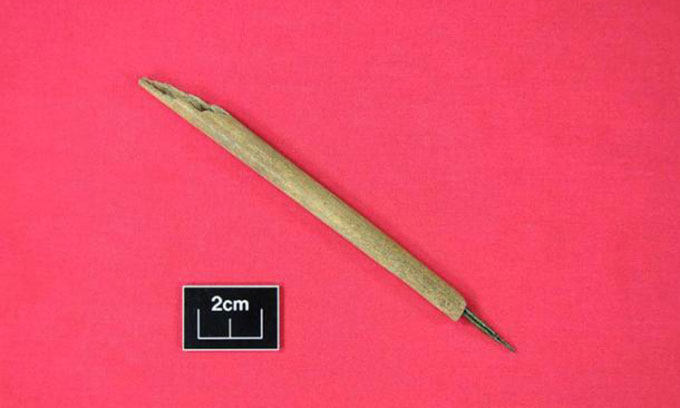Discovered 1,000-year-old ink pen made of bone in Ireland
The pen is composed of a bone tube and a metal nib that acts like an ink pen, suitable for drawing fine lines.
Archaeologist Michelle Comber at the National University of Ireland, Galway, unearthed a 1,000-year-old writing tool in the round fortress of Caherconnell, Ireland, the Mail on December 11 reported. This 43m-wide fortress was built in the late 10th century and was inhabited by the rich and local rulers until the early 1600s.

The ancient ink pen consisted of a hollow bone tube and a copper alloy nib.
Many other artefacts discovered at Caherconnell show that the fort's owners pursued diverse activities, from crafting and metalworking to business, games and music.
Most of the examples of ancient writing in Ireland come from the Church of Ireland, where diligent scribes transcribed every religious text. However, Dr. Comber believes the owner of the pen in Caherconnel used it to write about more mundane things like genealogy and business.
She also believes that this writing tool is the most complete and oldest composite pen (composite of many components and materials) ever discovered in the British Isles. It consists of a hollow bone tube and a copper alloy nib.
Perhaps the most curious thing about Caherconnell's pen, according to Comber, is its normal birth background rather than its religious background. "The Caherconnell Archaeological Project yielded a great harvest with many unexpected and interesting finds. However, this find exceeded all expectations, showing the unexpected growth of extra-religious writing in the region. Ireland in the 11th century," she said.
To confirm the Caherconnell pen was indeed the writing tool, Comber teamed up with archaeologist Adam Parsons to make a replica. When they tested the modern copy, they found it worked like a pen. This is a type of pen that does not have a typical ink tank like today's fountain pens, but needs to be regularly dipped into the bottle to replenish ink. This sets the Caherconnell pen apart because in the 11th century feather pens were the more common writing instrument.
The design of the Caherconnell pen is perfect for fine work, even for fine lines, says Tim O'Neill, historian and calligrapher. "It would be very suitable for drawing lines, for example creating a border for a page," says O'Neill.
- Drinking too much tea causes calcified bones
- Discovered carvings on an ancient tomb in Ireland
- The 1,000 year Viking wooden sword is still intact, not decaying: Made from expensive wood like gold!
- Discover structures made from hundreds of mammoth bones
- The 3D printer
- The summer heat wave reveals a 5,000-year-old circle in Ireland
- Detecting more 10 million-year-old jaw bone fossils in Kenya
- The world's first 3D jaw bone graft surgery
- Discovered more than 400 years old artillery out of Ireland
- The remains of a thousand year old skin remain intact after the storm in Ireland
- Mysterious 1000-year-old jaw bone on the beach
- Connect the bones of the screw made from ... human bones
 Discovered an ancient centipede fossil 99 million years old
Discovered an ancient centipede fossil 99 million years old Discovered bat-like dinosaurs in China
Discovered bat-like dinosaurs in China Discovered a 200-year-old bronze cannon of the coast
Discovered a 200-year-old bronze cannon of the coast Discover 305 million-year-old spider fossils
Discover 305 million-year-old spider fossils The truth behind NASA spending money on pen research in the universe
The truth behind NASA spending money on pen research in the universe  Discovered a 2,000-year-old iron pen engraved in English
Discovered a 2,000-year-old iron pen engraved in English  The title of the world's steepest road changed owners
The title of the world's steepest road changed owners  4 best weapons in China: The last one is the pure samurai of Japanese samurai
4 best weapons in China: The last one is the pure samurai of Japanese samurai  Use of small holes in ballpoint caps
Use of small holes in ballpoint caps  For the first time in history, China has produced its own ballpoint pen
For the first time in history, China has produced its own ballpoint pen 